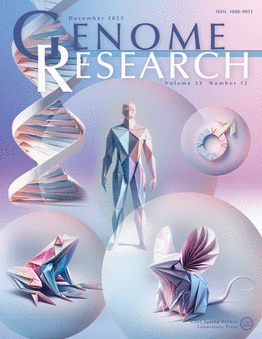利用半监督学习框架从纳米孔测序中检测 m6A RNA 修饰
IF 6.2
2区 生物学
Q1 BIOCHEMISTRY & MOLECULAR BIOLOGY
引用次数: 0
摘要
基于直接纳米孔的 RNA 测序可用于检测转录后碱基修饰,如 m6A 甲基化,其依据是修饰碱基的不同化学结构所产生的电流信号。一个关键的挑战是缺乏足够的已知甲基化修饰的训练数据。我们介绍的 Xron 是一种混合编码器-解码器框架,它通过对合成 RNA 数据和基于免疫沉淀的实验数据进行训练,分两步提供直接的甲基化区分碱基召唤器。首先,我们通过硅交叉连接生成具有更多样化修饰组合的数据。其次,我们利用该数据集训练端到端神经网络基底调用器,然后利用标签平滑技术对基于免疫沉淀的实验数据进行微调。经过训练的神经网络基底唤醒器在读数级和位点级预测得分上都优于现有的甲基化检测方法。Xron 是一种独立的端到端 m6A 区分碱基召唤器,能够直接从原始测序信号中检测甲基化碱基,从而实现从头甲基化组组装。本文章由计算机程序翻译,如有差异,请以英文原文为准。
Detecting m6A RNA modification from nanopore sequencing using a semi-supervised learning framework
Direct nanopore-based RNA sequencing can be used to detect post-transcriptional base modifications, such as m6A methylation, based on the electric current signals produced by the distinct chemical structures of modified bases. A key challenge is the scarcity of adequate training data with known methylation modifications. We present Xron, a hybrid encoder-decoder framework that delivers a direct methylation-distinguishing basecaller by training on synthetic RNA data and immunoprecipitation-based experimental data in two steps. First, we generate data with more diverse modification combinations through in silico cross-linking. Second, we use this dataset to train an end-to-end neural network basecaller followed by fine-tuning on immunoprecipitation-based experimental data with label-smoothing. The trained neural network basecaller outperforms existing methylation detection methods on both read-level and site-level prediction scores. Xron is a standalone, end-to-end m6A-distinguishing basecaller capable of detecting methylated bases directly from raw sequencing signals, enabling de novo methylome assembly.
求助全文
通过发布文献求助,成功后即可免费获取论文全文。
去求助
来源期刊

Genome research
生物-生化与分子生物学
CiteScore
12.40
自引率
1.40%
发文量
140
审稿时长
6 months
期刊介绍:
Launched in 1995, Genome Research is an international, continuously published, peer-reviewed journal that focuses on research that provides novel insights into the genome biology of all organisms, including advances in genomic medicine.
Among the topics considered by the journal are genome structure and function, comparative genomics, molecular evolution, genome-scale quantitative and population genetics, proteomics, epigenomics, and systems biology. The journal also features exciting gene discoveries and reports of cutting-edge computational biology and high-throughput methodologies.
New data in these areas are published as research papers, or methods and resource reports that provide novel information on technologies or tools that will be of interest to a broad readership. Complete data sets are presented electronically on the journal''s web site where appropriate. The journal also provides Reviews, Perspectives, and Insight/Outlook articles, which present commentary on the latest advances published both here and elsewhere, placing such progress in its broader biological context.
 求助内容:
求助内容: 应助结果提醒方式:
应助结果提醒方式:


